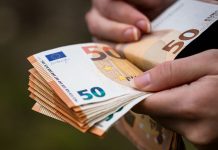Being short on cash is an expensive proposition: ask the Greeks or anyone whose luck has run out. The cash-strapped often spend more on credit than on food. Conversely, in order to put food on the table, the working poor turn to payday lenders. Here, cash advances to alleviate momentary crunches are easily obtained. However, the small loans often carry interest rates of 2,000% or more.
In the UK, the average annualised interest rate charged by payday lenders amounts to a staggering 1,415%. As of yet, there is no legislation that caps the rate non-bank credit providers may charge.
Surprisingly, the US maintains the cowboys of the financial services industry on a somewhat tighter leash. A growing number of states limit the maximum interest rate lenders can charge while Georgia bans the payday lending altogether, slapping offenders with felony charges of, amongst others, racketeering. Only fifteen states allow lenders a free rein in setting their rates and fees.
Nationwide, however, payday lending remains a hugely profitable business, collecting an estimated $3.5bn in fees plus untold billions in interest. Over 22,000 payday loan outlets now line America’s main streets – more than the number of Starbucks and MacDonald’s combined – and dispense close to $45bn annually in short-term loans. Up to 70% of that volume is earmarked for return customers who churn their loans every fortnight. Non-repeat borrowers account for barely 2% of the industry’s total business.
According to research from the Center for Responsible Lending in Durham, North Carolina, a typical payday loan amounts to $325 and is flipped eight times. At the end of the exercise, the borrower owes on average $468 in interest, requiring a disbursement of $793 to repay the original amount. In the US, the average annualised interest rate payday lenders charge hovers around the 500% mark.
The Federal Deposit Insurance Corporation (FDIC) estimates that around nine million US households have no access to mainstream banking services. Another 24 million are formally classified as underbanked – people who regularly turn to payday lenders for their financing needs. While the numbers have receded slightly from the peak they attained during the Great Recession, tens of millions of Americans are still shunned by fully-regulated financial services providers.

With wages flat-lining – the Q2 2015 numbers of the Department of Labor show just a 0.2% year-on-year increase in average earnings, the smallest rise since 1982 – America’s working poor struggle to cope with the financial fallout of even the smallest of setbacks such as a car breakdown or a higher-than-expected utility bill. Government studies show that over half of US households are unable to come up with $400 to head off minor emergencies.
It is on these deprived masses that the payday loan industry thrives. For Mehrsa Baradaran of the University of Georgia School of Law, the US currently operates two parallel financial systems: the well-regulated and government-supported banks that serve the well-off and a loose network of fringe operators – payday lenders, pawnshops, cheque-cashing outfits and assorted riffraff – that cater to the needs of “the other half.”
In How the Other Half Banks1, a well-researched exposé apparently written in anger, Ms Baradaran shows that since the decline of locally-owned credit unions and cooperative banks – or their absorption into larger corporate entities – the working poor have been excluded from the established financial services industry. Households getting by on an annual income of $25,000 or less have been disproportionally hit by the successive consolidation waves that hit the banking industry in the 1990s and early-2000s which was followed by the closure of thousands of local branches. In her book, Ms Baradaran cites a 2013 Bloomberg report that proves her case: US banks have lost interest in serving the working poor. Of the almost 2,000 bank branches that were shuttered between 2008 and 2013, fully 93% were located less affluent neighbourhoods.
The report found that the second-most underbanked county in the US may be found in – of all places – New York City. The 47,300 people of the Longwood neighbourhood of the Bronx must do with only two banks but are spoilt for choice when it comes to pawnshops and payday lenders.
Just before the Great Recession hit in 2008, this area of the Bronx, where the median household income is just shy of the national poverty line, was prime territory for the banks. In a process aptly called reverse redlining, banks were doling out mortgages by the bucket load to just about anybody with a pulse. Bundled together and properly securitised, these no-doc and low-doc loans were peddled to unsuspecting investors in the lead-up to the financial meltdown.
While in the years following, major financial institutions paid over $500m in fines to settle law suits initiated by financial regulators, most mortgage takers lost their slice of the American Dream and were left to fend for themselves. As banks turned their backs on the formerly lucrative poor, the payday lenders moved in. Rather than concluding, as Ms Baradaran does, that the US has two separate banking sectors each serving a distinct demographic, one may surmise that both take turns in extracting the most dollars out of those who have the least.
Footnotes
- How the Other Half Banks: Exclusion, Exploitation, and the Threat to Democracy by Mehsra Baradaran, Harvard University Press 2015 (£22.95/$29.95) – ISBN: 978-0-6742-8606-1































